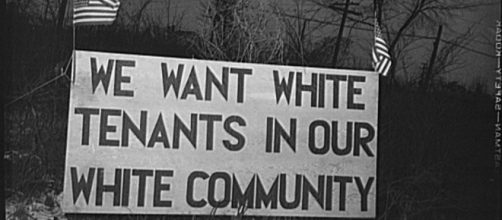Dr. Martin Luther King Jr. is honored for his contributions, but not just for African-American rights. He furthered civil rights for all Americans. MLK Jr. Day also commemorates the "I Have a Dream" speech famously given at the March on Washington for Jobs and Freedom, August 28, 1963. That speech might not have happened if not for the goddess of gospel Mahalia Jackson goading Dr. King, says Yahoo! Music. And, the Lincoln Memorial wasn't the first platform at which Dr. King spoke those words. Detroiters heard them first on June 23rd of that year, commemorating the 1943 race riots.
Detroit "Arsenal of Democracy" implodes
In 1943, Detroit and other industrial cities experienced a spate of racially motivated violence. WWII war production and Detroit's booming auto industry made the Motor City a mecca for job seekers, black and white. From 1940-1943, Detroit saw a northward migration similar to that of 1915 before WWI. The city had more jobs than workers to fill them, and the Dust Bowl sent 500,000 southerners to Detroit, including farmers, sharecroppers, impoverished Appalachians, and other unemployed. The exodus has been called Detroit's "Grapes of Wrath. The 10-percent African-American population didn't fare any better with immigrant whites up north than they had in the south.
"Detroit is Dynamite"
The Motor City was working full tilt in war production. One-third of all military equipment was produced in Detroit, earning it the title "Arsenal of Democracy." But all those people needed homes the city didn't have. Overworked, under-housed Detroiters were tense and exhausted, and that sparked always-simmering racial issues.
A 1942 LIFE magazine article, "Detroit Is Dynamite" predicted race riots in the powder-keg city. Riots might have been inaccurate because essentially, it was one race, whites, bullying blacks. On a sweltering hot Sunday, June 20, 1943 -- Father's Day -- the keg exploded. From Sunday to "Bloody Monday," June 21, thousands of angry whites trashed Detroit's black neighborhoods to protest the building of a black housing project.
Detroit can't live together, or separately
In 1943 there was one seriously overcrowded Brewster housing project for blacks. White housing projects were crowded too but there were many more of them. In those Jim Crow days, black Americans couldn't legally live with whites. When the city announced it was building another segregated black Sojourner Truth housing project, furious whites marched up Woodward Ave., and Vernor Highway, through black neighborhoods of Paradise Valley and Black Bottom, leaving a trail of destruction. In all, 34 people died. The Civil Rights Movement grew out of atrocities like this.
Martin Luther King praises, exhorts Detroit
In the spring of 1963, the Detroit Council for Human Rights called for a "Walk to Freedom" to commemorate the incident.
Many embers still burned from the 1943 conflagration. Dr. Martin Luther King Jr., United Auto Workers president Walter Reuther, Detroit Mayor Jerome Cavanagh, former Michigan Gov. John B. Swainson, and 125,000 people gathered. They marched up Woodward Avenue to Cobo Hall, where Dr. King praised Detroit's "Walk to Freedom" for its non-violent protest of oppression and police brutality.
Donald Trump, Barack Obama, and MLK Jr.
King discussed his dream of whites and blacks "walking together, hand in hand" in harmony and equality. This was the same vision, the same dream he shared in Washington, D.C., two months later. He would have rejoiced at the election of the first black President, Barack Obama.
Sadly, just a few short years after the speech, Detroit would be alight again over civil rights. Dr. King would not be alive to see the dream, his life ended by a bullet. Many hope the election of President-elect Donald Trump won't set civil rights back. Dr. Martin Luther King Jr. Day observances exhort people to keep the torch burning in memory of the past, and hope for the future.

